
Avenida General Sarmiento is an avenue located in the Palermo neighborhood, in Buenos Aires, Argentina. It runs from Plaza Italia to the Costanera Rafael Obligado Avenue, across the Parque Tres de Febrero.

Avenida General Sarmiento is an avenue located in the Palermo neighborhood, in Buenos Aires, Argentina. It runs from Plaza Italia to the Costanera Rafael Obligado Avenue, across the Parque Tres de Febrero.
When Governor Juan Manuel de Rosas installed its fifth resting on the grounds of the present Parque Tres de Febrero built the main house (Big House of Roses) in what today would be the intersection of Sarmiento Avenue and Libertador, and a building named "La Maestranza" in the west corner. The Avenue was a main road in fifth, with ombúes on both sides. After the defeat of Rosas in Caseros the Big House was used for several years as a military college and then as Naval School, and finally demolished on February 3, 1899. The following year, on 25 May, the monument inaugurated in place to Sarmiento, designed by Auguste Rodin. Moreover, La Maestranza building was demolished in 1924 and the site was a monument to Rosas, work of Ricardo Dalla Lasta opened in 1999.

For project and momentum of President Domingo Faustino Sarmiento (ruled 1868-1874) the area was improving, and in 1883, being Mayor Torcuato de Alvear, tropical palms were placed on both sides, according to the desire and impulse Sarmiento a decade ago and was called Avenida de las Palmeras. But these palms were not adapted to the climate and terrain and began to deteriorate, and to be turned into a kind of column with a tuft of withered leaves on top, popular with the nicknamed "the brooms and dusters Sarmiento" and the "Avenue of the Brooms". Eventually they were replaced by bananas, which still stand today.

In a plane Pedro Uzal, 1879 the track was already included with the name of Domingo Faustino Sarmiento. It had a porch in his initiation (at Santa Fe Avenue) known as the Gates of Palermo. These gave an elegant air and stretched from the entrance to the Zoo to the entrance of La Rural. They had three covers for the passage of carriages and two high arches on the sidewalks for pedestrians. Its gates railings had been forged in the smithy famous Zamboni Silvestre (Rivadavia and Talcahuano). Overnight closed to the passage of carts, to which in the early years were charged tolls ($5) as the riders ($3) by a law of 1878. But a few years will not be overcharged.
Between 1877 and 1912, compared to the solar where now stands the Galileo Galilei planetarium, Café Hansen worked with entrance by the avenue, which many consider one of the cradles of tango. In 1917 the gates were demolished.
The avenue begins in Plaza Italia, facing the Zoo and exhibition center of La Rural. It continues along the zoo and Francisco Seeber square, until the intersection with the Libertador Avenue, is at this junction the Monument to the Carta Magna and Four Regions of Argentina. in front of this is the monument to Domingo Faustino Sarmiento branch made by the famous French escurltor, Auguste Rodin. 300 meters later, at the intersection with Figueroa Alcorta Avenue is the located the monument to Justo Jose de Urquiza. Across the avenue on the left side is located the Galileo Galilei planetarium, and on the right the Egypt square.
Last ride of the avenue, passing under the railways bridges of San Martin and Mitre lines, and crossing a tunnel on the north branch of the Belgrano, is the end of the avenue, in a roundabout crossing the avenue Rafael Obligado where is located the monument to Jean Mermoz, on the north side of the Jorge Newbery Airport and across Fishing Club.
Images of some landmarks along this avenue.

Santo Domingo, once known as Santo Domingo de Guzmán and formerly known as Ciudad Trujillo, is the capital and largest city of the Dominican Republic and the largest metropolitan area in the Caribbean by population. As of 2022, the city and immediate surrounding area had a population of 1,973,664 while the total population is 4,579,536 when including Greater Santo Domingo. The city is coterminous with the boundaries of the Distrito Nacional, itself bordered on three sides by Santo Domingo Province.

Domingo Faustino Sarmiento was an Argentine activist, intellectual, writer, statesman and the second President of Argentina. His writing spanned a wide range of genres and topics, from journalism to autobiography, to political philosophy and history. He was a member of a group of intellectuals, known as the Generation of 1837, who had a great influence on 19th-century Argentina. He was particularly concerned with educational issues and was also an important influence on the region's literature.

Belgrano is a northern and leafy barrio or neighborhood of Buenos Aires, Argentina.

Palermo is a barrio or neighborhood of Buenos Aires, Argentina. It is located in the north of the city, near the Rio de la Plata.

Recoleta is a barrio or neighborhood of Buenos Aires, Argentina, located in the northern part of the city, by the Río de la Plata. The area is perhaps best known to be the home of the distinguished Recoleta Cemetery. It is a traditional upper-class and conservative neighborhood with some of the priciest real estate in the city, known for Paris-style townhouses, lavish former palaces and posh boutiques.

July 9 Avenue is a major thoroughfare in the city centre of Buenos Aires, Argentina. Its name honors Argentina's Independence Day, July 9, 1816.
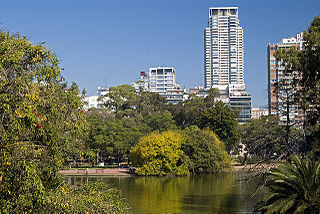
Parque Tres de Febrero, popularly known as Bosques de Palermo, is an urban park of approximately 400 hectares located in the neighborhood of Palermo in Buenos Aires, Argentina. Located between Libertador and Figueroa Alcorta Avenues, it is known for its groves, lakes, and rose gardens.

According to the World Travel & Tourism Council (WTTC) the travel and tourism sector of Argentina was moving towards recovering its pre-covid pandemic contribution to GDP in mid-2023, led by Buenos Aires.
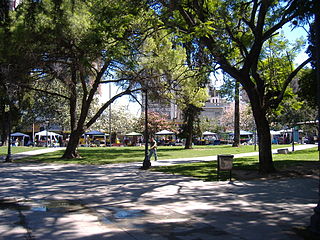
Plaza Sarmiento is a plaza in the city of Rosario, province of Santa Fe, Argentina. Its name is an homage to former Argentine president Domingo Faustino Sarmiento.
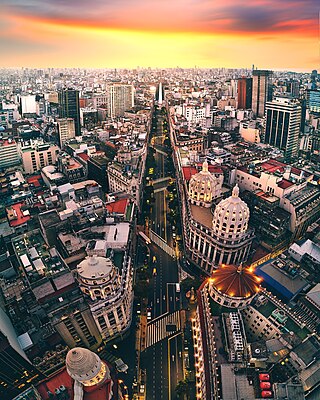
Avenida Roque Sáenz Peña, better known as Diagonal Norte, is an important avenue in the San Nicolás neighborhood of Buenos Aires, Argentina. It is oriented south-east/north-west, diagonally bisecting the city blocks (manzanas) which give the city centre a checkerboard plan. It is named after President Roque Sáenz Peña, who held power from 1910 to 1914 and passed the law which established universal suffrage, secret ballot and an electoral register.
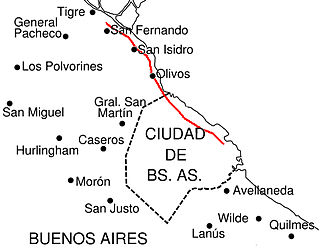
Avenida del Libertador is one of the principal thoroughfares in Buenos Aires, Argentina, and in points north, extending 25 km (16 mi) from the Retiro District of Buenos Aires to the northern suburb of San Fernando.

Avenida Figueroa Alcorta is a major thoroughfare in Buenos Aires, Argentina, with a length of over 7 km (4.3 mi) along the city's northside.

Plaza Miserere is a station on Line A of the Buenos Aires Underground. The station is located between Alberti and Loria / Pasco stations on the A line underground. Plaza Miserere has interchange with Once underground station of the H line and connection to the Sarmiento line commuter rail service within Once railway station, the central station of the Domingo Faustino Sarmiento Railway.

Plaza Italia station is part of the line D of the Buenos Aires Underground. It is located at the intersection of Avenida Santa Fe and the roundabout surrounding Plaza Italia in Palermo. The station was opened on 23 February 1940 as part of the extension of Line D from Tribunales to Palermo.
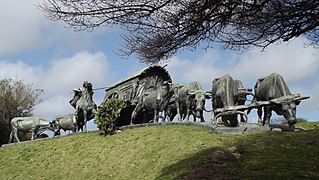
Parque Batlle, formerly Parque de los Aliados, is a barrio and a major public central park in Montevideo, Uruguay. It is named in honour of José Batlle y Ordóñez, President of Uruguay from 1903-1907 and 1911–1915.

Plaza Italia is a small park in the city of Buenos Aires in the barrio of Palermo on the confluence of Santa Fe Avenue and Avenida Sarmiento. Next to the plaza are the main entrances to the Zoo and the Botanical Gardens, and the la Rural Expo Center. The area is very busy with traffic, as it is a public transportation hub for the city.

Bustamante Park is an urban park in Providencia, Santiago de Chile. It is built on the former site of Pirque railroad station and adjacent classification yard. The park is bounded by Providencia Avenue on the north, just south of Plaza Baquedano, and Marín Street on the south.

Avenida Bolívar, in English Bolívar Avenue, is an important avenue located in the Libertador Bolivarian Municipality in the west of Caracas, the capital of Venezuela. The avenue's construction began on 25 July 1945, and it was opened on 31 December 1949 as part of the large project "Plan Rotival", which also included monuments like a new Capital building and a mausoleum for Simón Bolívar in the cemetery.
Eugenia Belín Sarmiento was an Argentinean painter and author. Her works were featured in various international shows, among them the first Exposición Anual de Pintura, Dibujo y Escultura for artists of South America in 1893. Critical response to her works has often focused attention on her portraits of her grandfather, Domingo Faustino Sarmiento, who was president of Argentina from 1868 to 1874. Eugenia completed many other works as well, including miniatures as well as full size portraits, paintings of flowers, birds, and still lives, and sculptures.
| | This section is empty. You can help by adding to it. (January 2016) |